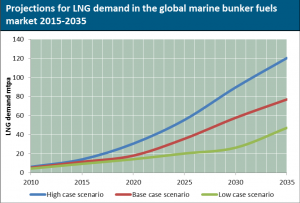November 2014, Vol. 241, No. 11
Features
Study Shows LNG Capturing Significant Market Share In Transport Sector By 2035

According to a new report by CEDIGAZ, the International Center for Natural Gas Information, LNG as a fuel will capture a significant market share in the transport sector by 2035.
The greatest potential is seen in road transport where annual demand is projected to reach 96 million tons per year (mtpa) in CEDIGAZ’ base scenario while demand in the marine sector could grow to an estimated 77 mtpa. The rail sector could add another 6 mtpa to global demand. However, the development of LNG as a transport fuel faces a number of challenges, and will have to go hand-in-hand with the development of fuelling infrastructure.
Fuel Cost Differentials
Use of LNG in land transport will be largely limited to heavy duty vehicles (HDV) and will essentially be driven by the difference between the price of diesel and that of LNG. In contrast with the marine sector, environmental legislation is unlikely to play a major role in triggering the adoption of LNG as a fuel for land transportation, as traditional fuels and technologies will be able to comply with the gradual tightening of emissions standards.

However, the cost advantage of LNG relative to diesel provides a strong economic incentive in the trucking industry. In its base scenario, CEDIGAZ projects a worldwide demand of 45 mtpa in 2025 growing to 96 mtpa in 2035, with China representing almost half the global market.
China has several features that combine to make it a prime candidate for the development of LNG in the road sector. The country has the world’s largest inland goods transport market and has already developed an extensive LNG supply infrastructure, initially as a means of transporting gas from remote fields or to consumers who were not connected to the pipeline supply network.
With at least 100,000 LNG vehicles and 1,100 refueling stations at the end of 2013, China already has a head start over the rest of the world in this nascent market. However, gas price reform in China may slow LNG growth there. LNG should also carve out a significant market share in the U.S., Europe and the rest of Asia.
Marine Sector Use
There is little doubt the use of LNG as a fuel will grow in the marine sector, though the rate and pace of growth will be highly dependent on the timing and geographical scope of emissions restrictions set out in the MARPOL treaty. Compliance with new emissions limits will require either: to switch to cleaner but more expensive oil-based fuels, to implement costly flue gas treatment technologies, or to switch to LNG.
Economic analysis taking into account all relevant factors (capex, opex, operational constraints, loss of cargo space etc.) show LNG to be a very attractive solution when compared to other compliance solutions, although the breakeven time will depend on several parameters such as the age of the vessel, the cost differential between LNG and traditional fuels, and the time spent in Emissions Control Areas (geographic areas with stricter emission standards under the MARPOL treaty).
CEDIGAZ’s base scenario projects the demand for LNG as a marine bunker fuel to reach 35.7 mtpa in 2025 and 77 mtpa in 2035.
Rail Sector Use
Rail has a relatively low share of energy consumption in the transport sector. In addition, the potential for LNG in the rail sector is likely to be most evident in countries with high levels of long-haul freight and low level of penetration of electric-powered traction in the freight sector, conditions found in relatively few countries.
In CEDIGAZ’s base case, LNG demand in rail is projected at 0.9 in 2025, 3 mtpa in 2030 and 6.2 mtpa in 2035. The countries with the highest potential are the United States, China and India.
For more information: info@cedigaz.org
Editor’s Note: CEDIGAZ (International Center for Natural Gas Information) is an international association with 90 members created in 1961 by a group of international gas companies and the Institut Français du Pétrole Energies nouvelles (IFPEN). CEDIGAZ collects and analyzes worldwide economic information on natural gas, LNG and unconventional gas.





Comments